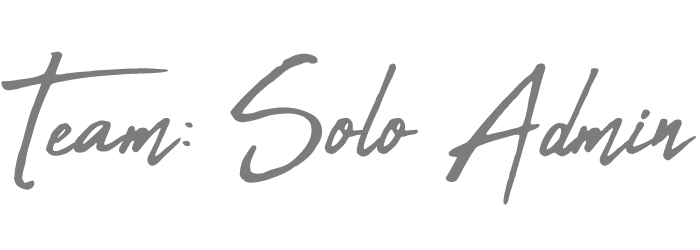Once you have a good understanding of the big picture and understand what an administrative system is, it’s time to create your own system.
This system for you. No one else.
Forethought When Creating Your Administrative System
When you sit down to think about how you want to set up your system, there are a few foundational keys to keep in mind. Please remember that all systems will forever be a work in progress. As organizations grow, so do our responsibilities. Be kind to yourself and be realistic.
Key 1: Keep Your Administrative System Simple
Your administrative system ultimately translates and marries the needs of your organization with the actual duties you must perform. While your organization could be very complex, your administrative system’s foundation should remain simple.
If that means grouping certain tasks or responsibilities, or creating a schedule that incorporates all of your critical items – do it! Creating groups or routines could be key to your success.
Key 2: Make Your Administrative System Flexible
Over time, you will find elements of your system that need to be changed or updated to keep up with the changes of your organization/department.
That is normal.
As I said before, your administrative system will never be a completed process. Most organizations are sure to change and evolve in some way. Your system needs to be able to allow new integrations and specifications.
Key 3: Construct Your Administrative System Like a Machine
Deciding how to keep track of routine events should be the foundation of your system.
You can incorporate evergreen deadlines in the system, for example, monthly budget reports. The system should be a starting area to help guide you.
By creating your own system, you establish a foundation upon which you can rely that offers consistency, reliability, and clarity. Having these elements can help you be a better a better admin, not just for your organization, but for yourself.
There are two main (or a combination of) ways to create a system: in real life (IRL/tangible) and virtually.
Tangible Administrative System

Unless you are a virtual administrative professional, more than likely will have tangible items to manage. For example, invoices, mail, and expense report submissions are a perfect example.
Deciding how you want to handle those items is important when you want to establish a way to keep track of them. Think about how you want your physical space to function for you. Consider getting any desk items you need to help manage those items as you see fit.
Your tangible administrative system does not have to be written down (unless you want to). Often, admins (myself included) can make use of their workspace as a tangible real life organizational system.
For example, in my office, anything to the left of my keyboard means that it’s a “to-do” item. Another example could be setting up your filing system, and consider how you keep track of files. When I had to keep actual file folders, I following my same e-filing rules.
Most of the time, this system develops over time. But by intentionally creating a system, you decrease the likelihood of creating additional chaos. You will always know what to do with any piece of documentation.
Virtual System
Your virtual system is a just as important as the IRL system.
Software
Later, I will provide a breakdown of applications that help to create your system, but for now, I will mention a few:
- Trello,
- Asana,
- Monday.com
- and OneNote.
I have written extensively about how I use Trello, so I won’t get into that here. Also, I offer introductory training sessions on Trello if you want to learn how to use Trello as an admin.
Anyhow, I recommend experimenting with all of them from an early stage. The longer you wait, the longer you feel like you can’t switch. I tried all of them out within my first year or two (maybe three).
Things to keep in mind when evaluating if your system is right for you:
- flexibility (If we hire someone can I easily let them join?),
- reliability (does the site go down often or have glitches), and
- ease of use (does it take me long learn/use the program?).
The only way to truly know if any of them work for you is by simply trying them. I typically test by adding a few projects (not all) to an application and see how well it works. If you forget to go to the application or often think “I don’t need to use it”. Chances are, it’s not for you.
Conversely, it might be for you if you picture your virtual system in your head throughout the day, or you prefer to start your day with it. If that’s the case, then consider adding a few more projects to it and continue to try it out.
Adjusting to a New System
Phasing out old systems is a really great way to adjust to a new system. Too many times I talk to admins and they see starting a new system as a massive project. They think they have to move everything and commit to one program, and it is not true.
You can test any application by using one full project to see if it gives you the capabilities you need. Many admins end up never finding the right program because, as an admin, work gets too busy to experiment. There’s no easy path, you have to take that first step to try a new application.
It can be very scary to throw all of your information into a program you don’t know. I understand that, but things won’t get better if nothing changes.
E-filing
E-filing systems can be an administrative nightmare if you’re not prepared.
I’m sure we’ve all experienced opening a seemingly innocent file folder, and it a monstrous amount of information that you don’t even remember putting there.
Well, that happens to all of us.
Creating an e-filing system/routine can help dramatically with that. Develop a system that at minimum helps you know where your files live. If you’re feeling fancy, consider always labeling your files a specific way.
For example, for expense files, I always do [Date.Vendor.Amount].
This is a crucial point to make sure your e-filing system is set up in a way that works best for you. Your aim is to set it up so that it can be as reliable as you are.
I typically start with a main category “Events,” “Admin,” or “Budgeting,” then inside each put the year the year [2021] I’m currently in.
I hope you enjoyed my tips and tricks on how to be a better admin by creating your administrative system. Remember, be kind to yourself. If the system doesn’t work, try something new. You’re awesome, and you’ll find a great solution.
Photo by Possessed Photography on Unsplash
Photo by Christa Dodoo on Unsplash


